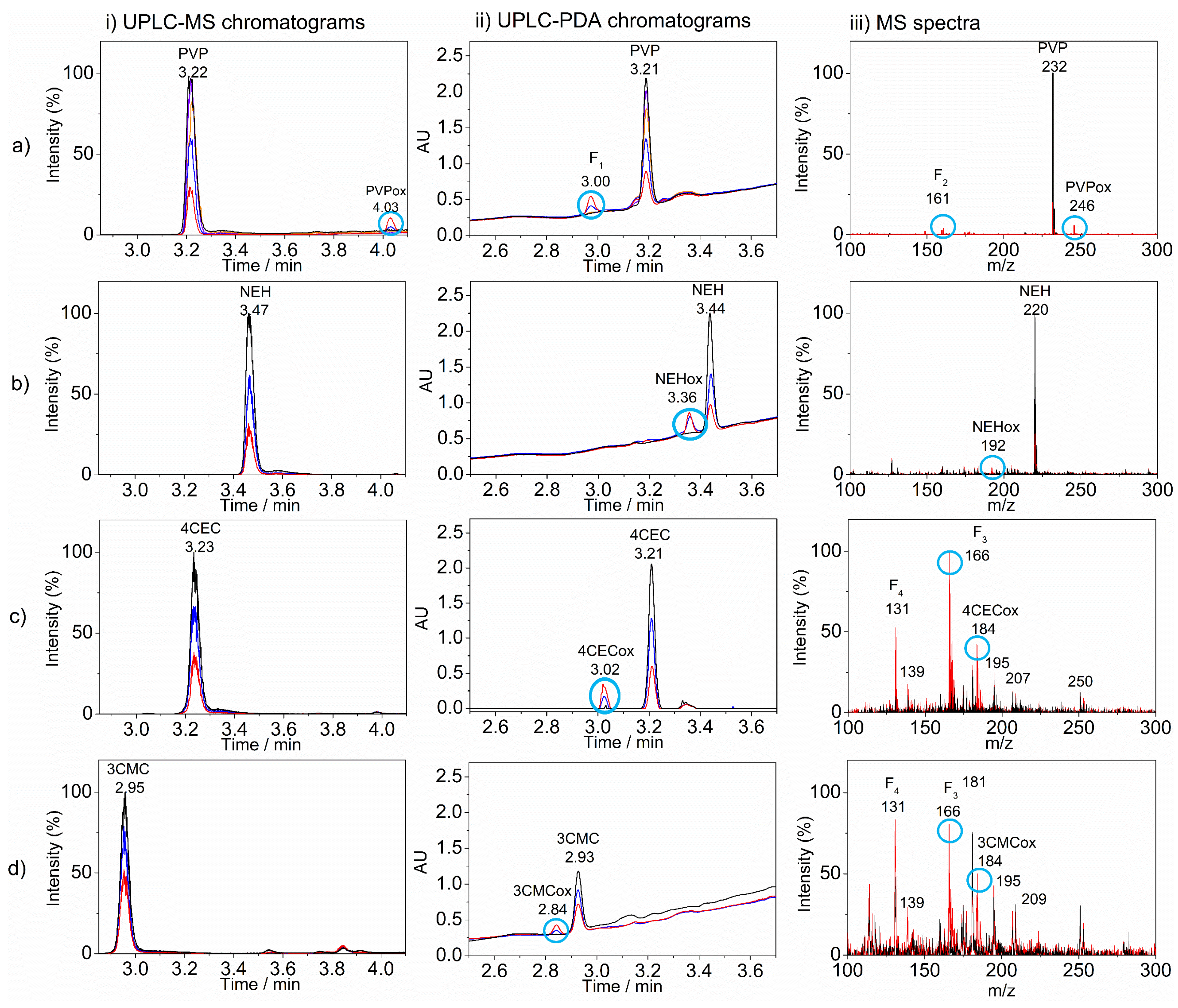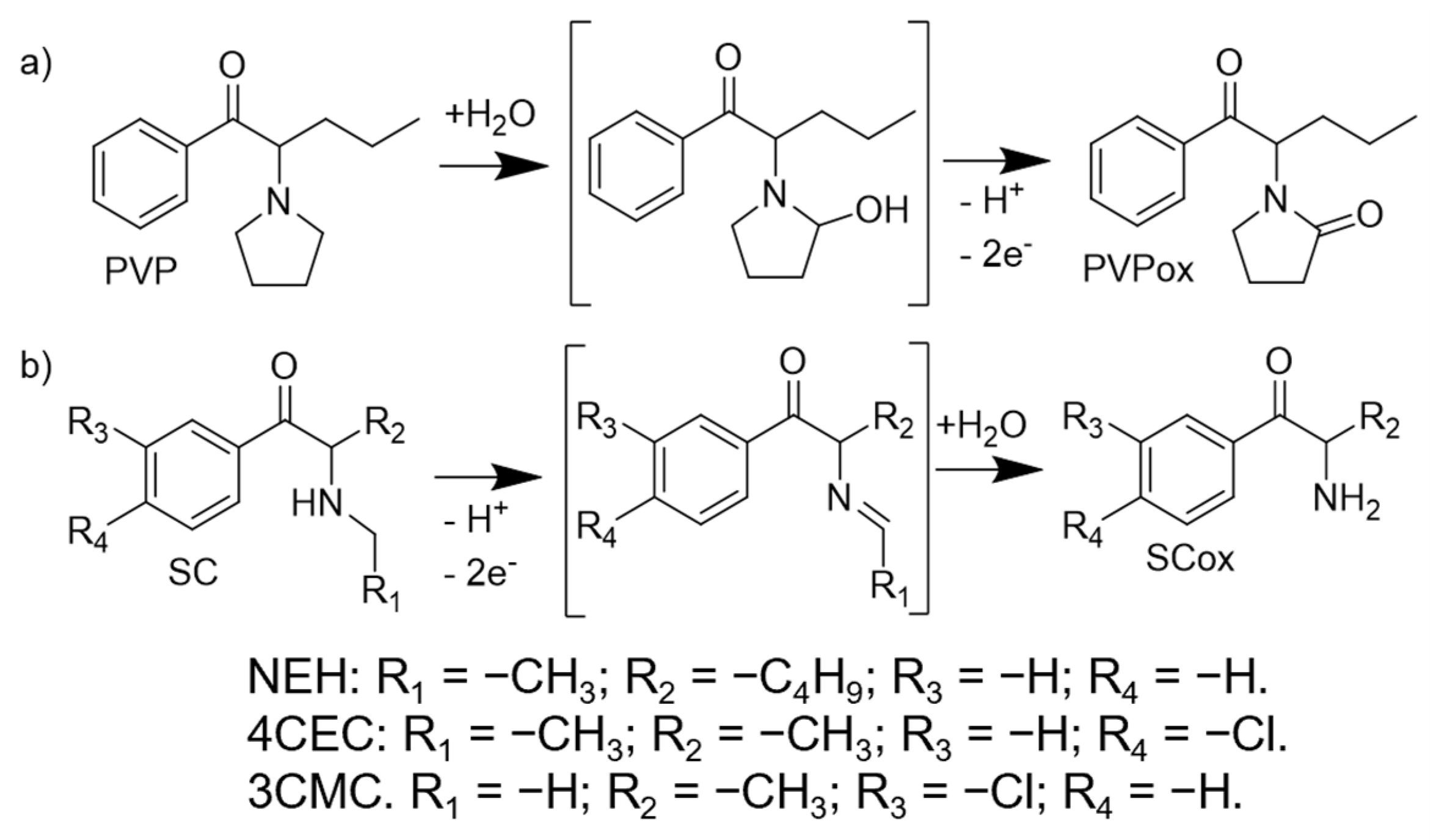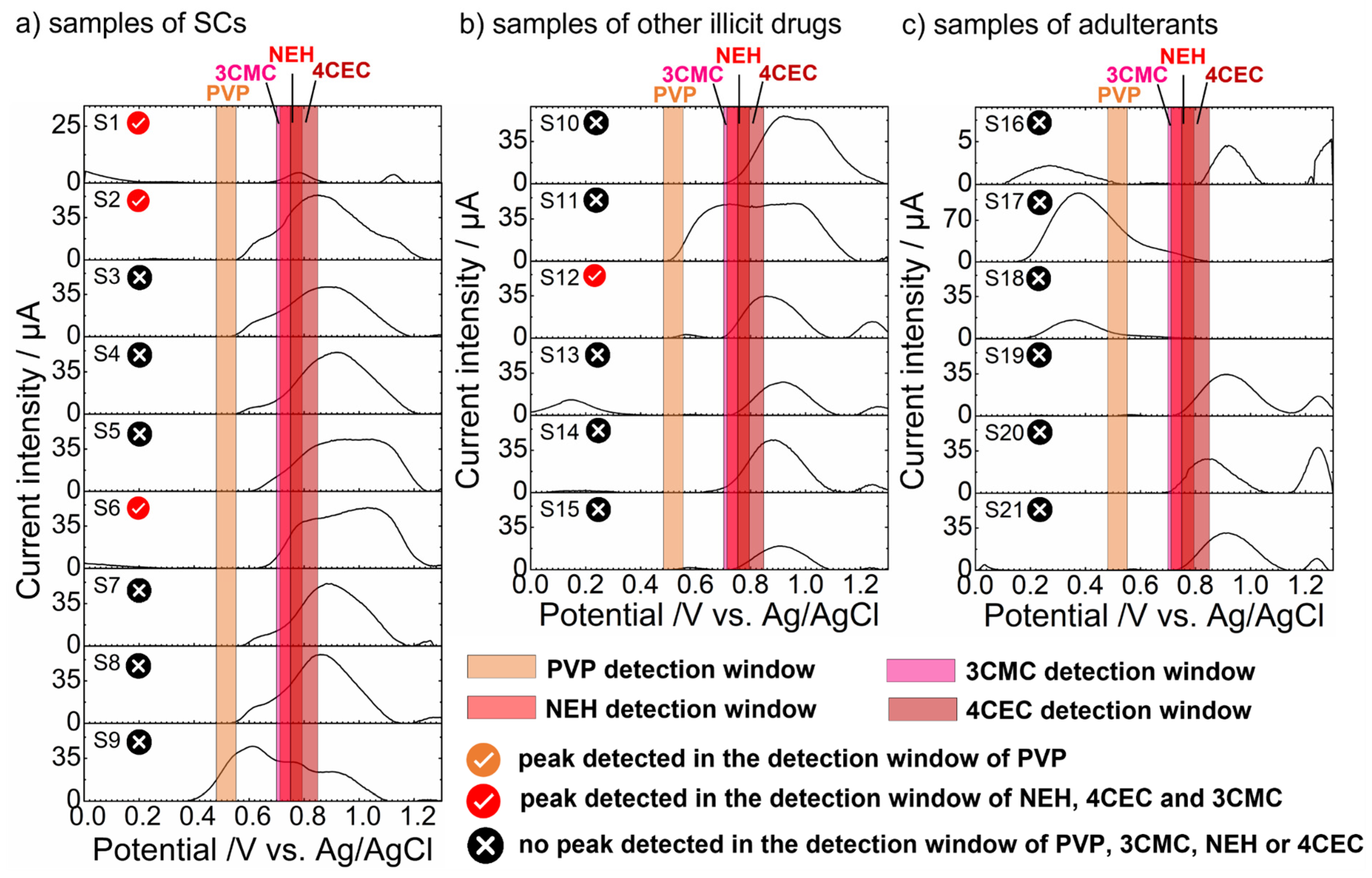Forensic Analysis of Synthetic Cathinones on Nanomaterials-Based Platforms: Chemometric-Assisted Voltametric and UPLC-MS/MS Investigation
Abstract
:1. Introduction
2. Materials and Methods
2.1. Materials and Instrumentation
2.2. Electrochemical Procedures
2.3. UPLC-PDA and UPLC-MS(/MS) Procedures
2.4. Chemometric Analysis
2.5. Analytical Performance
2.6. Confiscated Samples Analysis
3. Results
3.1. Electrochemical Behavior of the Investigated Molecules
3.2. Redox Pathways Elucidation
3.3. Chemometric Optimization of the Method
3.4. Analytical Performance of the Method
3.5. Confiscated Samples Analysis
4. Conclusions
Supplementary Materials
Author Contributions
Funding
Data Availability Statement
Conflicts of Interest
References
- Merone, G.M.; Tartaglia, A.; Rossi, S.; Santavenere, F.; Bassotti, E.; D’Ovidio, C.; Bonelli, M.; Rosato, E.; De Grazia, U.; Locatelli, M.; et al. Fast Quantitative LC-MS/MS Determination of Illicit Substances in Solid and Liquid Unknown Seized Samples. Anal. Chem. 2021, 93, 16308–16313. [Google Scholar] [CrossRef] [PubMed]
- Pieprzyca, E.; Skowronek, R.; Nižnanský, Ľ.; Czekaj, P. Synthetic Cathinones—From Natural Plant Stimulant to New Drug of Abuse. Eur. J. Pharmacol. 2020, 875, 173012. [Google Scholar] [CrossRef] [PubMed]
- Riley, A.L.; Nelson, K.H.; To, P.; López-Arnau, R.; Xu, P.; Wang, D.; Wang, Y.; Shen, H.-w.; Kuhn, D.M.; Angoa-Perez, M.; et al. Abuse Potential and Toxicity of the Synthetic Cathinones (i.e., “Bath Salts”). Neurosci. Biobehav. Rev. 2020, 110, 150–173. [Google Scholar] [CrossRef]
- Gatch, M.B.; Shetty, R.A.; Sumien, N.; Forster, M.J. Behavioral Effects of Four Novel Synthetic Cathinone Analogs in Rodents. Addict. Biol. 2021, 26, e12987. [Google Scholar] [CrossRef]
- European Monitoring Centre for Drugs and Drug Addiction (EMCDDA). European Drug Report 2022: Trends and Developments; Publications Office of the European Union: Luxembourg, 2022. [Google Scholar]
- United Nations Office on Drugs and Crime (UNODC). World Drug Report 2022. Booklet 4—Drug Market Trends: Cocaine, Amphetamine-Type Stimulants, New Psychoactive Substances; UNODC: Vienna, Austria, 2022. [Google Scholar]
- Dragan, A.-M.; Parrilla, M.; Feier, B.; Oprean, R.; Cristea, C.; De Wael, K. Analytical Techniques for the Detection of Amphetamine-Type Substances in Different Matrices: A Comprehensive Review. TrAC Trends Anal. Chem. 2021, 145, 116447. [Google Scholar] [CrossRef]
- Shen, B.; Li, J.; Cheng, W.; Yan, Y.; Tang, R.; Li, Y.; Ju, H.; Ding, S. Electrochemical Aptasensor for Highly Sensitive Determination of Cocaine Using a Supramolecular Aptamer and Rolling Circle Amplification. Microchim. Acta 2015, 182, 361–367. [Google Scholar] [CrossRef]
- Bruker. The Toxtyper. Available online: https://www.bruker.com/en/products-and-solutions/mass-spectrometry/ms-solutions/toxtyper.html (accessed on 3 June 2023).
- Agilent. Agilent Resolve Raman—Handheld Raman System. Available online: https://www.agilent.com/cs/library/brochures/5991-8867EN_Resolve_brochure_CPOD-web.pdf (accessed on 4 June 2023).
- Labtron. Portable Trace Drug Detector LTDD-A20. Available online: https://www.labtron.com/trace-drug-detector/ltdd-a20 (accessed on 24 February 2023).
- Rigaku. Advanced Narcotics Analyzer-Progeny ResQ FLX—Handheld Raman Analyzers. Available online: https://www.azom.com/equipment-details.aspx?EquipID=5748 (accessed on 4 June 2023).
- Metrohm. MIRA DS Advanced XL—Instant Raman Analyzer. Available online: https://www.metrohm.com/ro_ro/products/raman-spectroscopy/mira-ds-mira-xtr-ds.html (accessed on 3 June 2023).
- Nuctech Europe. Explosives and Narcotics Trace Detector. Available online: https://nuctecheurope.com/products/nuctech-tr1000qc-explosives-and-narcotics-trace-detector (accessed on 4 June 2023).
- VIAVI Solutions. MicroNIR OnSite-W. Available online: https://www.viavisolutions.com/en-us/osp/products/micronir-onsite-w (accessed on 4 June 2023).
- Bruker. MOBILE-IR II FT-IR Spectrometer. Available online: https://www.bruker.com/ko/products-and-solutions/infrared-and-raman/ft-ir-routine-spectrometer/mobile-ir-ii-ft-ir-spectrometer.html (accessed on 29 May 2023).
- DetectaChem. Handheld Drug and Explosive Detector. Available online: https://www.detectachem.com/product-info/seekere-explosive-detection/ (accessed on 3 June 2023).
- European Monitoring Centre for Drugs and Drug Addiction. Synthetic Cathinones Drug Profile. Available online: https://www.emcdda.europa.eu/publications/drug-profiles/synthetic-cathinones_en (accessed on 31 May 2023).
- United Nations Office on Drugs and Crime. Recommended Methods for the Identification and Analysis of Synthetic Cathinones in Seized Materials; United Nations Office on Drugs and Crime: Vienna, Austria, 2022. [Google Scholar]
- Florea, A.; de Jong, M.; De Wael, K. Electrochemical Strategies for the Detection of Forensic Drugs. Curr. Opin. Electrochem. 2018, 11, 34–40. [Google Scholar] [CrossRef]
- Parrilla, M.; Slosse, A.; Van Echelpoel, R.; Montiel, N.F.; Langley, A.R.; Van Durme, F.; De Wael, K. Rapid On-Site Detection of Illicit Drugs in Smuggled Samples with a Portable Electrochemical Device. Chemosensors 2022, 10, 108. [Google Scholar] [CrossRef]
- Shaw, L.; Dennany, L. Applications of Electrochemical Sensors: Forensic Drug Analysis. Curr. Opin. Electrochem. 2017, 3, 23–28. [Google Scholar] [CrossRef]
- Schram, J.; Parrilla, M.; Sleegers, N.; Van Durme, F.; Van Den, J.; van Nuijs, A.L.N.; De Wael, K. Electrochemical Profiling and LC-MS Characterization of Synthetic Cathinones: From Methodology to Detection in Forensic Samples. Drug Test. Anal. 2021, 13, 1282–1294. [Google Scholar] [CrossRef]
- Lima, C.D.; Couto, R.A.S.; Arantes, L.C.; Marinho, P.A.; Pimentel, D.M.; Quinaz, M.B.; da Silva, R.A.B.; Richter, E.M.; Barbosa, S.L.; dos Santos, W.T.P. Electrochemical Detection of the Synthetic Cathinone 3,4-Methylenedioxypyrovalerone Using Carbon Screen-Printed Electrodes: A Fast, Simple and Sensitive Screening Method for Forensic Samples. Electrochim. Acta 2020, 354, 136728. [Google Scholar] [CrossRef]
- Parrilla, M.; Joosten, F.; De Wael, K. Enhanced Electrochemical Detection of Illicit Drugs in Oral Fluid by the Use of Surfactant-Mediated Solution. Sens. Actuators B Chem. 2021, 348, 130659. [Google Scholar] [CrossRef]
- Fiorentin, T.R.; Krotulski, A.J.; Martin, D.M.; Browne, T.; Triplett, J.; Conti, T.; Logan, B.K. Detection of Cutting Agents in Drug-Positive Seized Exhibits within the United States. J. Forensic Sci. 2019, 64, 888–896. [Google Scholar] [CrossRef] [PubMed]
- Gannon, B.M.; Galindo, K.I.; Mesmin, M.P.; Rice, K.C.; Collins, G.T. Reinforcing Effects of Binary Mixtures of Common Bath Salt Constituents: Studies with 3,4-Methylenedioxypyrovalerone (MDPV), 3,4-Methylenedioxymethcathinone (Methylone), and Caffeine in Rats. Neuropsychopharmacology 2018, 43, 761–769. [Google Scholar] [CrossRef]
- Leffler, A.M.; Smith, P.B.; de Armas, A.; Dorman, F.L. The Analytical Investigation of Synthetic Street Drugs Containing Cathinone Analogs. Forensic Sci. Int. 2014, 234, 50–56. [Google Scholar] [CrossRef]
- Oliver, C.F.; Palamar, J.J.; Salomone, A.; Simmons, S.J.; Philogene-Khalid, H.L.; Stokes-McCloskey, N.; Rawls, S.M. Synthetic Cathinone Adulteration of Illegal Drugs. Psychopharmacology 2019, 236, 869–879. [Google Scholar] [CrossRef]
- ISO17025; Testing and Calibration Laboratories. ISO Publishing: Geneve, Switzerland, 2017.
- Lockwood, T.L.E.; Leong, T.X.; Bliese, S.L.; Helmke, A.; Richard, A.; Merga, G.; Rorabeck, J.; Lieberman, M. IdPAD: Paper Analytical Device for Presumptive Identification of Illicit Drugs. J. Forensic Sci. 2020, 65, 1289–1297. [Google Scholar] [CrossRef]
- Kranenburg, R.F.; Verduin, J.; de Ridder, R.; Weesepoel, Y.; Alewijn, M.; Heerschop, M.; Keizers, P.H.J.; van Esch, A.; van Asten, A.C. Performance Evaluation of Handheld Raman Spectroscopy for Cocaine Detection in Forensic Case Samples. Drug Test. Anal. 2021, 13, 1054–1067. [Google Scholar] [CrossRef]
- Kranenburg, R.F.; Ramaker, H.J.; van Asten, A.C. On-Site Forensic Analysis of Colored Seized Materials: Detection of Brown Heroin and MDMA-Tablets by a Portable NIR Spectrometer. Drug Test. Anal. 2022, 14, 1762–1772. [Google Scholar] [CrossRef]
- Kranenburg, R.F.; Ou, F.; Sevo, P.; Petruzzella, M.; de Ridder, R.; van Klinken, A.; Hakkel, K.D.; van Elst, D.M.J.; van Veldhoven, R.; Pagliano, F.; et al. On-Site Illicit-Drug Detection with an Integrated near-Infrared Spectral Sensor: A Proof of Concept. Talanta 2022, 245, 123441. [Google Scholar] [CrossRef]
- Dragan, A.M.; Parrilla, M.; Sleegers, N.; Slosse, A.; Van Durme, F.; van Nuijs, A.; Oprean, R.; Cristea, C.; De Wael, K. Investigating the Electrochemical Profile of Methamphetamine to Enable Fast On-Site Detection in Forensic Analysis. Talanta 2023, 255, 124208. [Google Scholar] [CrossRef] [PubMed]
- Yang, Z.; Zhang, X.; Guo, J. Functionalized Carbon-Based Electrochemical Sensors for Food and Alcoholic Beverage Safety. Appl. Sci. 2022, 12, 9082. [Google Scholar] [CrossRef]
- Dragan, A.-M.; Truta, F.M.; Tertis, M.; Florea, A.; Schram, J.; Cernat, A.; Feier, B.; De Wael, K.; Cristea, C.; Oprean, R. Electrochemical Fingerprints of Illicit Drugs on Graphene and Multi-Walled Carbon Nanotubes. Front. Chem. 2021, 9, 641147. [Google Scholar] [CrossRef] [PubMed]
- Shima, N.; Katagi, M.; Kamata, H.; Matsuta, S.; Sasaki, K.; Kamata, T.; Nishioka, H.; Miki, A.; Tatsuno, M.; Zaitsu, K.; et al. Metabolism of the Newly Encountered Designer Drug α- Pyrrolidinovalerophenone in Humans: Identification and Quantitation of Urinary Metabolites. Forensic Toxicol. 2014, 32, 59–67. [Google Scholar] [CrossRef]
- Frański, R.; Gierczyk, B.; Kasperkowiak, M.; Jankowski, W.; Hoffmann, M. The Mechanism of Water Loss from Protonated Cathinones. Rapid Commun. Mass Spectrom. 2020, 34, 34–37. [Google Scholar] [CrossRef]
- Arrieiro, M.O.B.; Arantes, L.C.; Moreira, D.A.R.; Pimentel, D.M.; Lima, C.D.; Costa, L.M.F.; Verly, R.M.; dos Santos, W.T.P. Electrochemical Detection of Eutylone Using Screen-Printed Electrodes: Rapid and Simple Screening Method for Application in Forensic Samples. Electrochim. Acta 2022, 412, 140106. [Google Scholar] [CrossRef]
- Schram, J.; Parrilla, M.; Sleegers, N.; Samyn, N.; Bijvoets, S.M.; Heerschop, M.W.J.; van Nuijs, A.L.N.; De Wael, K. Identifying Electrochemical Fingerprints of Ketamine with Voltammetry and Liquid Chromatography-Mass Spectrometry for Its Detection in Seized Samples. Anal. Chem. 2020, 92, 13485–13492. [Google Scholar] [CrossRef]
- Shishkanova, T.V.; Vatrsková, L.; Spálovská, D.; Králík, F.; Cuřínová, P.; Winkler, M.; Budka, J.; Jurásek, B.; Kuchař, M.; Setnička, V. Complexation of Cathinones by 4-tert-Butylcalix[4]arene Tetra-Acetate as a Possible Technique for Forensic Analysis. Forensic Toxicol. 2020, 38, 70–78. [Google Scholar] [CrossRef]
- Jiang, X.; Wu, F.; Huang, X.; He, S.; Han, Q.; Zhang, Z.; Liu, W. Fabrication of a Molecularly-Imprinted-Polymer-Based Graphene Oxide Nanocomposite for Electrochemical Sensing of New Psychoactive Substances. Nanomaterials 2023, 13, 751. [Google Scholar] [CrossRef]
- Zuway, K.Y.; Smith, J.P.; Foster, C.W.; Kapur, N.; Banks, C.E.; Sutcliffe, O.B. Detection and Quantification of New Psychoactive Substances (NPSs) within the Evolved “Legal High” Product, NRG-2, Using High Performance Liquid Chromatography-Amperometric Detection (HPLC-AD). Analyst 2015, 140, 6283–6294. [Google Scholar] [CrossRef]
- Smith, J.P.; Metters, J.P.; Khreit, O.I.G.; Sutcliffe, O.B.; Banks, C.E. Forensic Electrochemistry Applied to the Sensing of New Psychoactive Substances: Electroanalytical Sensing of Synthetic Cathinones and Analytical Validation in the Quantification of Seized Street Samples. Anal. Chem. 2014, 86, 9985–9992. [Google Scholar] [CrossRef] [PubMed]
- Tan, F.; Smith, J.P.; Sutcliffe, O.B.; Banks, C.E. Regal Electrochemistry: Sensing of the Synthetic Cathinone Class of New Psychoactive Substances (NPSs). Anal. Methods 2015, 7, 6470–6474. [Google Scholar] [CrossRef]
- Smith, J.P.; Metters, J.P.; Irving, C.; Sutcliffe, O.B.; Banks, C.E. Forensic Electrochemistry: The Electroanalytical Sensing of Synthetic Cathinone-Derivatives and Their Accompanying Adulterants in “Legal High” Products. Analyst 2014, 139, 389–400. [Google Scholar] [CrossRef] [PubMed]
- Shishkanova, T.V.; Štěpánková, N.; Tlustý, M.; Tobrman, T.; Jurásek, B.; Kuchař, M.; Trchová, M.; Fitl, P.; Vrňata, M. Electrochemically Oxidized 15-Crown-5 Substituted Thiophene and Host-Guest Interaction with New Psychoactive Substances. Electrochim. Acta 2021, 373, 137862. [Google Scholar] [CrossRef]
- Scheel, G.L.; de Oliveira, F.M.; de Oliveira, L.L.G.; Medeiros, R.A.; Nascentes, C.C.; Tarley, C.R.T. Feasibility Study of Ethylone Determination in Seized Samples Using Boron-Doped Diamond Electrode Associated with Solid Phase Extraction. Sens. Actuators B Chem. 2018, 259, 1113–1122. [Google Scholar] [CrossRef]
- Couto, R.A.S.; Coelho, C.; Mounssef, B., Jr.; Morais, S.F.d.A.; Lima, C.D.; dos Santos, W.T.P.; Carvalho, F.; Rodrigues, C.M.P.; Braga, A.A.C.; Gonçalves, L.M.; et al. 3,4-Methylenedioxypyrovalerone (MDPV) Sensing Based on Electropolymerized Molecularly Imprinted Polymers on Silver Nanoparticles and Carboxylated Multi-Walled Carbon Nanotubes. Nanomaterials 2021, 11, 353. [Google Scholar] [CrossRef]
- Cao, Q.; Jiang, D.; Zheng, L.; Xu, F.; Shiigi, H.; Shan, X.; Wang, W.; Chen, Z. Dual-Binding Domain Electrochemiluminescence Biosensing Platform with Self-Checking Function for Sensitive Detection of Synthetic Cathinone in e-Cigarettes. Biosens. Bioelectron. 2023, 224, 114963. [Google Scholar] [CrossRef]
- Melo, L.M.A.; Arantes, L.C.; Schaffel, I.F.; Aranha, L.M.S.; Conceição, N.S.; Lima, C.D.; Marinho, P.A.; Ferreira, R.Q.; dos Santos, W.T.P. Electrochemical Detection of Mephedrone Using a Graphene Screen-Printed Electrode: A New Sensitive and Selective Approach to Identify Synthetic Cathinones in Forensic Analysis. Analyst 2023, 148, 1552–1561. [Google Scholar] [CrossRef]
- Couto, R.A.S.; Mounssef, B.; Carvalho, F.; Rodrigues, C.M.P.; Braga, A.A.C.; Aldous, L.; Gonçalves, L.M.; Quinaz, M.B. Methylone Screening with Electropolymerized Molecularly Imprinted Polymer on Screen-Printed Electrodes. Sens. Actuators B Chem. 2020, 316, 128133. [Google Scholar] [CrossRef]






| Synthetic Cathinone | Platform | Equation | R2 |
|---|---|---|---|
| PVP (peak 1) | G-SPEs | Ep (V) = −0.025 pH + 0.924 | 0.783 |
| GPH-SPEs | Ep (V) = −0.029 pH + 0.872 | 0.755 | |
| MWCNT-SPEs | Ep (V) = −0.021 pH + 0.834 | 0.741 | |
| NEH | G-SPEs | Ep (V) = −0.029 pH + 1.236 | 0.920 |
| GPH-SPEs | Ep (V) = −0.011 pH + 0.938 | 0.557 | |
| MWCNT-SPEs | Ep (V) = −0.024 pH + 1.086 | 0.902 | |
| 4CEC | G-SPEs | Ep (V) = −0.032 pH + 1.302 | 0.729 |
| GPH-SPEs | Ep (V) = −0.011 pH + 0.938 | 0.557 | |
| MWCNT-SPEs | Ep (V) = −0.020 pH + 1.065 | 0.456 | |
| 3CMC | G-SPEs | Ep (V) = −0.036 pH + 1.333 | 0.999 |
| GPH-SPEs | Ep (V) = −0.040 pH + 1.205 | 0.992 | |
| MWCNT-SPEs | Ep (V) = −0.028 pH + 1.121 | 0.999 |
| SCs | Platform | Technique | LOD (µM) | Linear Range (µM) | Real Sample | Ref. |
|---|---|---|---|---|---|---|
| 4Cl-aPVP | G-SPE | SWV | 39.9 | 50–500 | street samples | [41] |
| 4Cl-aPVP | SDS-G-SPE | AdSDPV | 1.6 | 2.5–30 | oral fluid | [25] |
| 4F-NEB | CEM | POT | NP | 119.57–4128.83 | - | [42] |
| 4MEC | GO-MIPs/GCE | DPV | 2.29 | 26.14–313.69 | - | [43] |
| 4MEC | G-SPE | HPLC-AMP | 48.9 | 261.51–2615.06 | street samples | [44] |
| 4MEC | Bi/Hg-G-SPE | CV | 60.67 | 523.01–2092.05 | street samples | [45] |
| 4MEC | Coin | CV | 2.61 | 0.005–0.52 | street samples | [46] |
| 4MMC | G-SPE | HPLC-AMP | 82.78 | 282.33–2823.26 | street samples | [47] |
| 4MMC | Bi/Hg-G-SPE | CV | 66.59 | 564.33–2257.34 | street samples | [45] |
| 4MMC | Coin | CV | 3.16 | 0.006–0.56 | street samples | [46] |
| BUP | TH3CA4AB15C5—PtDE | EIS | NP | 20–1220 | - | [48] |
| BUP | CEM | POT | NP | 118.51–4221.22 | - | [42] |
| BUTY | G-SPE | SWV | 65.3 | 100–500 | street samples | [41] |
| ETC | G-SPE | SWV | 157.2 | 200–1000 | street samples | [41] |
| EUTY | C-SPE | DPV | 2 | 20–600 | street samples | [40] |
| EUTY | BDDE | SPEX-SWV | 3.7 | 13–88 | street samples | [49] |
| MDPPP | TH3CA4AB15C5–PtDE | EIS | NP | 39.9–1220 | - | [48] |
| MDPPP | CEM | POT | NP | 12.13–4015.37 | - | [42] |
| MDPV | C-MWCNT-SPE-AgNP-MIP | SWV | 1.8 | 1.8–75 | - | [50] |
| MDPV | MDPV-CBSA-SF/MIL-68@Sn-TCPP/GCE | ECL | 5.08 × 10−16 | 3.63 × 10−15–3.63 × 10−9 | e-cigarettes | [51] |
| MDPV | G-SPE | AdSDPV | 0.5 | 1.6–100 | street samples | [24] |
| MEP | G-SPE | SWV | 27.8 | 100–1000 | street samples | [41] |
| MEP | GPH-SPE | AdSDPV | 0.3 | 2.6–112 | - | [52] |
| METY | G-SPE | SWV | 79.2 | 100–500 | street samples | [41] |
| METY | Au-SPE-MIP | SWV | 1.1 | 3.6–50 | urine, serum | [53] |
| METY | CEM | POT | NP | 188.22–2813.71 | - | [42] |
| MEP | MIP/PT/MWCNT@AuNPs GCE | SWV | 0.0008 | 0.001–0.01; 0.01–0.1 | urine, plasma | [53] |
| PVP | GPH-SPEs | SWV | 1.67 | 5–1000 | street samples | This work |
| NEH | GPH-SPEs | 16.67 | 50–250 | |||
| 4CEC | GPH-SPEs | 8.33 | 25–100; 100–1000 | |||
| 3CMC | GPH-SPEs | 25 | 75–500 |
| Device | TP | TN | FP | FN | Sensitivity | Specificity | Accuracy |
|---|---|---|---|---|---|---|---|
| EC reader | 2 | 17 | 2 | 0 | 100.00 | 89.47 | 90.48 |
| Raman device | 3 | 6 | 0 | 11 | 21.43 | 100.00 | 45.00 |
Disclaimer/Publisher’s Note: The statements, opinions and data contained in all publications are solely those of the individual author(s) and contributor(s) and not of MDPI and/or the editor(s). MDPI and/or the editor(s) disclaim responsibility for any injury to people or property resulting from any ideas, methods, instructions or products referred to in the content. |
© 2023 by the authors. Licensee MDPI, Basel, Switzerland. This article is an open access article distributed under the terms and conditions of the Creative Commons Attribution (CC BY) license (https://creativecommons.org/licenses/by/4.0/).
Share and Cite
Dragan, A.-M.; Feier, B.G.; Tertiș, M.; Bodoki, E.; Truta, F.; Ștefan, M.-G.; Kiss, B.; Van Durme, F.; De Wael, K.; Oprean, R.; et al. Forensic Analysis of Synthetic Cathinones on Nanomaterials-Based Platforms: Chemometric-Assisted Voltametric and UPLC-MS/MS Investigation. Nanomaterials 2023, 13, 2393. https://doi.org/10.3390/nano13172393
Dragan A-M, Feier BG, Tertiș M, Bodoki E, Truta F, Ștefan M-G, Kiss B, Van Durme F, De Wael K, Oprean R, et al. Forensic Analysis of Synthetic Cathinones on Nanomaterials-Based Platforms: Chemometric-Assisted Voltametric and UPLC-MS/MS Investigation. Nanomaterials. 2023; 13(17):2393. https://doi.org/10.3390/nano13172393
Chicago/Turabian StyleDragan, Ana-Maria, Bogdan George Feier, Mihaela Tertiș, Ede Bodoki, Florina Truta, Maria-Georgia Ștefan, Béla Kiss, Filip Van Durme, Karolien De Wael, Radu Oprean, and et al. 2023. "Forensic Analysis of Synthetic Cathinones on Nanomaterials-Based Platforms: Chemometric-Assisted Voltametric and UPLC-MS/MS Investigation" Nanomaterials 13, no. 17: 2393. https://doi.org/10.3390/nano13172393
APA StyleDragan, A.-M., Feier, B. G., Tertiș, M., Bodoki, E., Truta, F., Ștefan, M.-G., Kiss, B., Van Durme, F., De Wael, K., Oprean, R., & Cristea, C. (2023). Forensic Analysis of Synthetic Cathinones on Nanomaterials-Based Platforms: Chemometric-Assisted Voltametric and UPLC-MS/MS Investigation. Nanomaterials, 13(17), 2393. https://doi.org/10.3390/nano13172393











